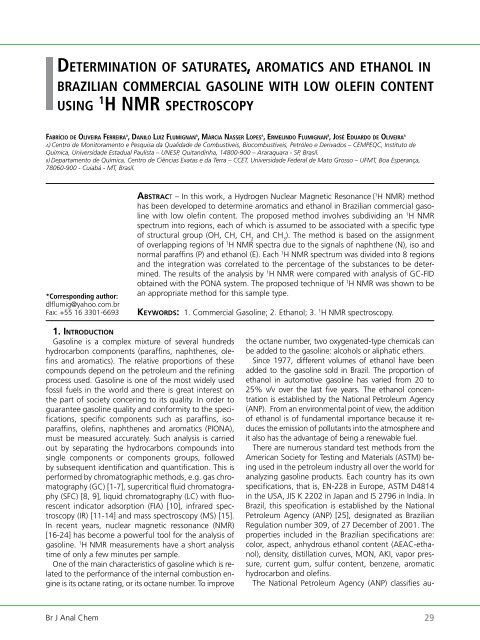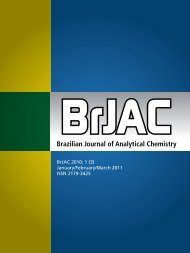Brazilian Journal of Analytical Chemistry - BRJAC - Brazilian Journal ...
Brazilian Journal of Analytical Chemistry - BRJAC - Brazilian Journal ...
Brazilian Journal of Analytical Chemistry - BRJAC - Brazilian Journal ...
You also want an ePaper? Increase the reach of your titles
YUMPU automatically turns print PDFs into web optimized ePapers that Google loves.
de T e r m i n a T i o n o f s a T u ra T e s, a ro m a T i C s a n d e T h a n o l in<br />
b ra z i l i a n C o m m e r C i a l g a s o l i n e w iT h l o w o l e f i n C o n T e n T<br />
u s i n g 1 h nmr speCTrosCopy<br />
fabríCio d e oliveira ferreira a , da n i l o luiz fl u m i g n a n a , márCia nasser lo p e s a , er m e l i n d o fl u m i g n a n b , Jo s é ed u a rd o d e oliveira a<br />
a) Centro de Monitoramento e Pesquisa da Qualidade de Combustíveis, Biocombustíveis, Petróleo e Derivados – CEMPEQC, Instituto de<br />
Química, Universidade Estadual Paulista – UNESP, Quitandinha, 14800-900 – Araraquara - SP, Brasil.<br />
b) Departamento de Química, Centro de Ciências Exatas e da Terra – CCET, Universidade Federal de Mato Grosso – UFMT, Boa Esperança,<br />
78060-900 - Cuiabá - MT, Brasil.<br />
*Corresponding author:<br />
dlflumig@yahoo.com.br<br />
Fax: +55 16 3301-6693<br />
Br J Anal Chem<br />
Ab s t r A c t – In this work, a Hydrogen Nuclear Magnetic Resonance ( 1 H NMR) method<br />
has been developed to determine aromatics and ethanol in <strong>Brazilian</strong> commercial gasoline<br />
with low olefin content. The proposed method involves subdividing an 1 H NMR<br />
spectrum into regions, each <strong>of</strong> which is assumed to be associated with a specific type<br />
<strong>of</strong> structural group (OH, CH, CH 2 and CH 3 ). The method is based on the assignment<br />
<strong>of</strong> overlapping regions <strong>of</strong> 1 H NMR spectra due to the signals <strong>of</strong> naphthene (N), iso and<br />
normal paraffins (P) and ethanol (E). Each 1 H NMR spectrum was divided into 8 regions<br />
and the integration was correlated to the percentage <strong>of</strong> the substances to be determined.<br />
The results <strong>of</strong> the analysis by 1 H NMR were compared with analysis <strong>of</strong> GC-FID<br />
obtained with the PONA system. The proposed technique <strong>of</strong> 1 H NMR was shown to be<br />
an appropriate method for this sample type.<br />
Ke y w o r d s : 1. Commercial Gasoline; 2. Ethanol; 3. 1 H NMR spectroscopy.<br />
1. In t r o d u c t Io n<br />
Gasoline is a complex mixture <strong>of</strong> several hundreds<br />
hydrocarbon components (paraffins, naphthenes, olefins<br />
and aromatics). The relative proportions <strong>of</strong> these<br />
compounds depend on the petroleum and the refining<br />
process used. Gasoline is one <strong>of</strong> the most widely used<br />
fossil fuels in the world and there is great interest on<br />
the part <strong>of</strong> society concering to its quality. In order to<br />
guarantee gasoline quality and conformity to the specifications,<br />
specific components such as paraffins, isoparaffins,<br />
olefins, naphthenes and aromatics (PIONA),<br />
must be measured accurately. Such analysis is carried<br />
out by separating the hydrocarbons compounds into<br />
single components or components groups, followed<br />
by subsequent identification and quantification. This is<br />
performed by chromatographic methods, e.g. gas chromatography<br />
(GC) [1-7], supercritical fluid chromatography<br />
(SFC) [8, 9], liquid chromatography (LC) with fluorescent<br />
indicator adsorption (FIA) [10], infrared spectroscopy<br />
(IR) [11-14] and mass spectroscopy (MS) [15].<br />
In recent years, nuclear magnetic ressonance (NMR)<br />
[16-24] has become a powerful tool for the analysis <strong>of</strong><br />
gasoline. 1 H NMR measurements have a short analysis<br />
time <strong>of</strong> only a few minutes per sample.<br />
One <strong>of</strong> the main characteristics <strong>of</strong> gasoline which is related<br />
to the performance <strong>of</strong> the internal combustion engine<br />
is its octane rating, or its octane number. To improve<br />
the octane number, two oxygenated-type chemicals can<br />
be added to the gasoline: alcohols or aliphatic ethers.<br />
Since 1977, different volumes <strong>of</strong> ethanol have been<br />
added to the gasoline sold in Brazil. The proportion <strong>of</strong><br />
ethanol in automotive gasoline has varied from 20 to<br />
25% v/v over the last five years. The ethanol concentration<br />
is established by the National Petroleum Agency<br />
(ANP). From an environmental point <strong>of</strong> view, the addition<br />
<strong>of</strong> ethanol is <strong>of</strong> fundamental importance because it reduces<br />
the emission <strong>of</strong> pollutants into the atmosphere and<br />
it also has the advantage <strong>of</strong> being a renewable fuel.<br />
There are numerous standard test methods from the<br />
American Society for Testing and Materials (ASTM) being<br />
used in the petroleum industry all over the world for<br />
analyzing gasoline products. Each country has its own<br />
specifications, that is, EN-228 in Europe, ASTM D4814<br />
in the USA, JIS K 2202 in Japan and IS 2796 in India. In<br />
Brazil, this specification is established by the National<br />
Petroleum Agency (ANP) [25], designated as <strong>Brazilian</strong><br />
Regulation number 309, <strong>of</strong> 27 December <strong>of</strong> 2001. The<br />
properties included in the <strong>Brazilian</strong> specifications are:<br />
color, aspect, anhydrous ethanol content (AEAC-ethanol),<br />
density, distillation curves, MON, AKI, vapor pressure,<br />
current gum, sulfur content, benzene, aromatic<br />
hydrocarbon and olefins.<br />
The National Petroleum Agency (ANP) classifies au-<br />
29



